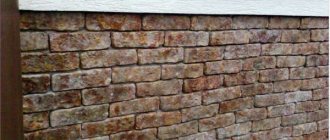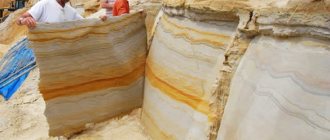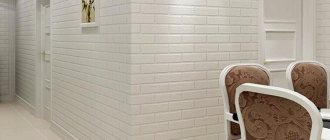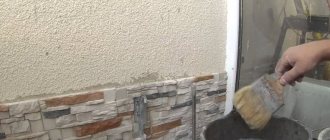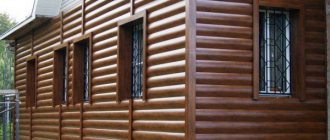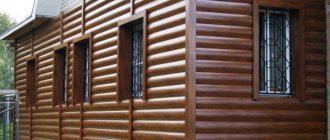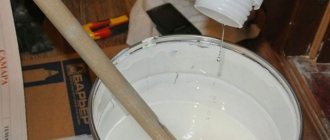Siding is an easy-to-use, durable and aesthetic facing material.
The use of siding allows you to significantly save on the purchase of material and on installation work, since installation does not require any special training, the work is quite accessible to everyone.
The result of covering a house with siding is the appearance of a neat, stylish and durable exterior cladding that very reliably imitates a wooden or stone surface.
It is the high level of imitation, combined with ease of installation and relative cheapness of the material, that has brought siding to the forefront in terms of prevalence and popularity.
Among the wide variety of types of cladding, stone siding occupies a special place and deserves a detailed description.
Stone-look facade panels
Finishing the facade completes the cycle of work on building a house.
At this stage, budgets are often limited, so homeowners begin searching among siding manufacturers for suitable solutions. The range of budget cladding is not always limited to long, single-color strips. Polyvinyl chloride is given the noble texture of stone. And they are shaped in such a way that the joints on the façade remain invisible. Stone-look facade panels, depending on the chosen manufacturer, are more or less similar to natural masonry. The color palette also varies. The market offers options with the texture of wild stone, sandstone, masonry with elements of regular geometry in gray, brown, beige, white and other colors. Some manufacturers carry out finishing processing manually. The design of each element is unique and the texture is very realistic to the touch. The most striking example is materials from Doke.
House facade decor
To improve the facade of your home, you can use simple design techniques. Decorative stone inserts in the plinth area:
Decor of the entrance area, corners and windows:
Contrasting gypsum board inserts plus stucco molding:
Beautiful exquisite facade
Foam decor in half-timbered style:
Facade painting:
Decorative shutters:
You can decorate the entrance group with railings, a canopy, and interesting entrance steps.
A canopy over the entrance decorates the facade
Stone steps complete the appearance of the facade
You can equip a terrace and glaze it, trim it with wood or decorate it in a Mediterranean style.
When choosing what to cover the facade of a house with, it is better to be guided by the climatic conditions of the area in which the house is located, the requirements for the stability of the finish, as well as individual stylistic preferences.
If you have decided, choosing methods for finishing facades is not a problem.
Advantages and disadvantages
It makes a lot of sense to use imitation masonry panels for building exteriors and here's why:
- There is no need to level the wall, sand or prime it. Any irregularities will be hidden by the plates.
- The structure of the material gives it heat and sound insulating qualities.
- One person is enough for installation.
- The weight of the slabs is small; the foundation and walls do not need to be strengthened. For old buildings - an excellent option.
- The cladding looks realistic and respectable.
- The material is not afraid of moisture, sunlight, and temperature changes.
- The cost of production is lower compared to conventional natural stone.
- It is easy to care for - you just need to wash off the dirt with water.
- The service life of the panels reaches 50 years.
Fiber cement boards with a stone texture cannot offer a 100% realistic picture. In addition, they are afraid of shock loads and weigh 22-40 kg, which is quite a lot. Plus, fiber cement siding tends to absorb moisture. There is one bonus that distinguishes them from plastic - complete safety and environmental friendliness due to their natural composition.
Video description
You can see how different houses lined with such siding look thanks to this selection:
Convenient operation
Significant strength characteristics and resistance to external factors do not require additional maintenance efforts throughout the entire period of operation. There is no need for tinting or filling cracks that have nowhere to appear.
Siding stone, unlike a natural material, is lightweight, which greatly facilitates loading, assembly and installation work, and reduces transportation costs. The material is suitable for finishing old buildings that cannot withstand heavy structures.
Cladding an old building will hide external imperfections Source bg.decorexpro.com
It does not require complicated maintenance; dust deposits can be easily washed off with a stream of water from a hose.
Are there any disadvantages
The material has only one obvious drawback - it does not have the strength of natural stone. The siding is made of high-quality material, but it can be destroyed by a strong impact, and to replace one panel you will have to dismantle a decent area.
Kinds
Stone-look facade panels for exterior decoration are structurally divided into composite and homogeneous.
Composite plates are made from several layers of different properties. Composite siding has an outer layer that is decorative, while the inner layer is made up of insulation, most often polystyrene foam.
Homogeneous panels consist only of an outer covering, be it plastic or fiber cement. They are flexible, do not deform and are lightweight. Homogeneous products are cheaper.
Stages of work
- As a rule, at the stage of preparation for installation, you need to process the wall with your own hands to attach the façade panels. First, all protrusions are removed, then the old cladding is cleaned, and then the wall is treated with an agent that prevents the formation of fungus. If the walls are uneven, then the panels will be mounted on a frame, wooden or metal.
- The base should be checked for evenness using a building level. If the differences are more than 1 centimeter, then attaching the panels with glue will be impossible. In this case, alignment is carried out. In addition, the walls, both brick and concrete, must be primed, and wooden ones are treated with an antiseptic.
- Installation of the sheathing occurs in advance. The frame is constructed in a vertical or horizontal arrangement of all constituent elements. The lathing should not copy the uneven surface of the wall. A gap must be left between the facing material and the wall for ventilation. The cavity formed between the surface of the building and the panels is filled with insulating materials, foam plastic or mineral wool. Before proceeding with the installation of the sheathing, it is necessary to lay a fairly thick and durable cellophane film.
It is important to correctly determine the level of the first row of cladding using the starting strip. Wall panels are usually fixed from ground level at a height of 30 centimeters
It is advisable to start cladding from the corners. After the first row is ready, all gaps between the wall and the material are filled with polyurethane foam. If during the process it turns out that the panel does not fit in a row, it is cut with a grinder.
Fiber cement panels are mounted with self-tapping screws. Metal plates are attached to the sheathing after insulating the façade of private houses. Plastic panels are mounted on the frame using fasteners. Clinker, as well as fiber cement, are attached to self-tapping screws.
- The vinyl panels are connected to each other using latches, one of which is located on the edge. In this way, sections of different sizes are assembled, which are then attached using self-tapping screws to the wall of the building. The panels are secured with locks and simultaneously cover the perforated fastening area from view. Installation is carried out overlapped from the ground, horizontally. Holes for self-tapping screws are cut with a certain gap, which will come in handy in case of swelling or contraction of materials during temperature fluctuations. Nails are selected from aluminum or other anti-corrosion material.
- Polyurethane panels are connected to each other like a “ridge” and “groove”, and are mounted vertically. The façade covering is attached to the frame with stainless steel screws, which will be invisible upon completion of the work.
- Sandwich panels are attached to the frame with self-tapping screws in the case of wooden and metal sheathing, and on concrete walls - with dowels. The panels are also connected to each other using a tongue-and-groove system. This scheme is chosen to prevent moisture from entering the walls of the house and to create high-quality adhesion between the parts.
- The porcelain stoneware façade is installed using glue. It must consist of two components, one of which is polyurethane. The tiles are glued to a cellular fiberglass surface, which will prevent fragments from falling in the event of damage.
Review of manufacturers
Finishing materials on the Russian market are offered by domestic companies and foreign manufacturers. The largest market share is occupied by such brands as Döcke, Novik, Nailaite, KMEW and the Russian Alta-profile, Dolomit, Tekhosnastka.
Döcke is a German brand that produces 6 collections of stone panels with different textures. A unique finishing technique makes the material incredibly similar to real rock. The quality of the products is very high.
Novik is a Canadian manufacturer. Its assortment includes façade elements whose texture resembles field and river stone, ashlar and ashlar limestone, as well as wild stone. The panels are very strong and durable. They have an increased thickness of 2 mm and are suitable for various regions of the country.
The American brand Nailaite offers siding with the texture of rubble, hewn, and natural stone. The manufacturer offers more than 2,500 combinations of façade and basement cladding options.
For those who choose fiber cement boards instead of polymer siding, a large selection of materials is offered by the Japanese brand KMEW. Among analogues from other manufacturers, it is the panels of these brands that have the lowest water absorption rate.
Figure 6. Types of panels
Number one among Russian brands is “Alta-profile”. The brand offers as many as 44 solutions for masonry: rubble, granite, wild stone, etc. The products meet international quality standards and are sold not only in Russia, but also abroad.
The Fineber brand is also known to Russian buyers. The manufacturer produces as many as 9 stone collections in several colors. The material is considered environmentally friendly and safe. Visually, it is very similar to natural stone, so the cladding does not reveal its origin. For ease of installation and aesthetic results, Fineber produces corner elements that can be matched to the color of the facade or played in contrast.
PVC panels are also produced by the Dolomit company. Its basement siding collections offer a choice of interesting solutions with various textures, such as rocky reef, sandstone, slate, dolomite, and alpine stone. Profiles that are 3 meters long simplify installation. The service life stated by the manufacturer is 50 years.
The company “European Construction Technologies” is also engaged in the production of stone-look facade panels. It produces cladding for external walls of buildings under the Hardplast brand. The buyer's choice is limited to one slate texture, which is available in gray, red and brown. The material for the manufacture of facade siding is a polymer-sand mixture.
Figure 7. Stone color scheme for façade panels
Training film for installing basement siding
Features of choice
Choosing the right material is not always easy. There are a number of parameters that should be considered before making a decision:
- Unity of structure. The panels must have a uniform color corresponding to the stone imitation. They also pay attention to the thickness: sharp transitions that are not related to relief and texture indicate low quality.
The color of the panel must be uniform, and the dimensions must comply with the stated standards. - Size. Although the parameters for all varieties are almost identical (length – 113–117 cm, width – 45–55 cm, thickness – 17–35 mm), it is recommended to select products that provide the least amount of trimming.
- Availability of additional elements. To work, you will need additional details: external and internal corners of similar texture, starting and finishing profiles. All components and main panels must be manufactured by the same manufacturer.
- Desired imitation stone. The following options are found: rubble, granite, torn, burnt, dolomite, cobblestone, wild, rocky rocks.
The type and color of the plinth panels are selected for different types of design. - It is also important to have certificates of conformity and step-by-step instructions from the manufacturer with information about the characteristics of the material and how to work with it.
Recommendations for use
When installing it yourself, you need to calculate the required amount of cladding. To do this, it is more convenient to use a façade calculator. You can take measurements differently. To do this, calculate the area of each wall minus window and door openings. Additionally, the area of the gables is taken into account. Always add 10-20% to the resulting amount of measurements for cutting. Additionally, the lengths of all corners and the perimeter are measured for the purchase of additional elements.
For installation you will need these tools: saw, drill, tape measure, level, sharp knife. Self-tapping screws are required for fastening. It is best to take ones with a zinc coating - they are more durable.
For the sheathing, choose a treated timber or metal profile. The latter option is better, as it eliminates the risk that the sheathing will become unusable before the cladding.
If the house is being insulated, the insulation sheets are laid overlapping. This way you can avoid cold bridges.
There is a set of rules that must be followed in order for the result to please you.
- It is better to start installation from the bottom corner of the building;
- installation should be carried out in horizontal rows;
- leave a gap of 5 cm between the elements of the first row and the ground;
- when connecting different fragments, leave a small indent;
- fix the elements not tightly to the sheathing (the coefficient of thermal expansion must be taken into account);
- fix the screws clearly in the center of the technological holes to avoid deformation of the material;
- leave a compensation gap between the last row and the roof of the building.
Recommendations for caring for the finished facade are simple:
- wash off dirt as necessary with plain water;
- Do not use alkali or acids for cleaning.
Step-by-step installation
To install sandwich panels yourself, you should prepare:
- hammer;
- screwdriver;
- level;
- roulette;
- centimeter;
- hacksaw/grinder;
- pencil/marker/chalk.
Before installation, the walls should be prepared. Remains of cement mortar, moisture stains, and metal elements are removed from them. The surface is treated with a special compound that prevents the appearance of fungi and insects. After the solution has dried, begin installing the blocks.
The installation of the slabs is carried out on the prepared sheathing. If it is planned to lay insulation, heat-insulating blocks are installed first.
Step-by-step installation of stone siding.
- The sheathing is installed on the wall. To do this, use wooden blocks or metal slats. The planks are arranged in increments of 30 - 40 cm. They not only serve as support for the blocks, but also help to ventilate the walls.
Several types of profiles are used in the lathing Source manesu.com
- The starting bar is set. It is verified by level and the rest of the blocks are oriented according to it.
- Corner panels and window panels are installed. Blocks are installed around doorways.
- The following panels are carefully fastened to the corner blocks. The locks should be snapped in a smooth motion so as not to break the structure.
- Fixation with self-tapping screws is carried out with a small allowance. The cap is not screwed into the sheathing all the way, leaving 1-2 mm.
- Each next row of panels is leveled. Sandwich panels should be installed from left to right.
First, the blocks are installed on a flat surface. After installing all the panels, the corner parts are secured. They snap easily onto the mounting profile.
The main condition for high-quality installation of sandwich panels is accuracy. German Holzplast Wandstein panels have proven themselves well. Plinth blocks require special attention.
Spectacular examples in the exterior
For inspiration, we offer photo stone-look façade panels for viewing.
Figure 8. Option for decorating a house using stone-look facade panels
Figure 9. Option for decorating a house using stone-look facade panels
Figure 10. Option for decorating a house using stone-look facade panels
Figure 11. Option for decorating a house using stone-look facade panels
Figure 12. Option for decorating a house using stone-look facade panels

